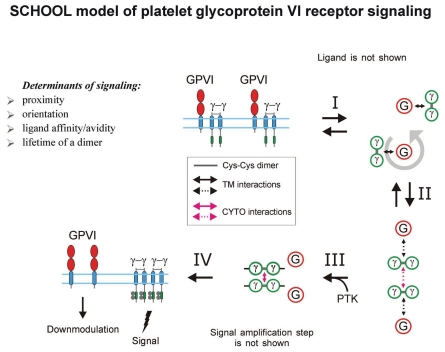Figure 11.
SCHOOL model of GPVI signaling. Interaction with multivalent ligand (not shown) clusters the receptors and pushes them to reorientate (I), to bring signaling subunits into a correct (permissive) relative orientation and in sufficient proximity in the formed receptor oligomer (for illustrative purposes, receptor dimer is shown), and thus to promote the trans-homointeractions between FcRγ homodimers (II). Formation of competent signaling oligomers results in phosphorylation of the ITAM tyrosines, thus triggering the activation signal. Then, the signaling oligomers formed subsequently dissociate from GPVI, resulting in downmodulation of the remaining engaged receptor chains (IV). Stages I and II can be reversible or irreversible depending on interreceptor proximity and relative orientation of the receptors in ligand-specific dimers/oligomers as well as on time duration of the receptor-ligand contact and lifetime of the receptor in these dimers/oligomers that generally correlate with the nature of the stimulus and its specificity and affinity/avidity. Further, the signaling oligomers formed can sequentially interact with the signaling subunits of nonengaged receptors resulting in formation of higher-order signaling oligomers, thus amplifying and propagating the activation signal (not shown). Also, this leads to the release and subsequent downmodulation of the nonengaged GPVI chains (not shown). Immunoreceptor tyrosine-based activation motifs (ITAMs) are shown as green rectangles. Receptor components are represented as whole polypeptides and as a simplified axial view. Black and magenta arrows indicate specific intersubunit hetero- and homointeractions between transmembrane and cytoplasmic domains, respectively. All interchain interactions in intermediate complexes are shown by dotted arrows reflecting their transition state. Circular arrow indicates ligand-induced receptor reorientation. Phosphate groups are shown as filled gray circles. In an axial view, one solid small black line depicts one phosphorylated ITAM domain. Abbreviations: PTK, protein tyrosine kinase; SCHOOL, signaling chain homooligomerization; GPVI, glycoprotein VI receptor.

